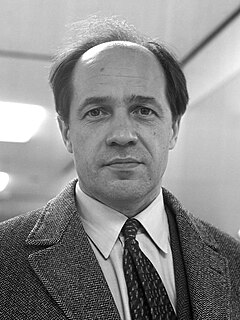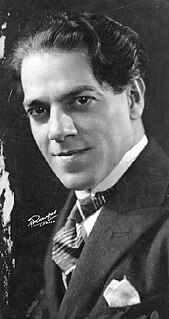
A percussion instrument is a musical instrument that is sounded by being struck or scraped by a beater including attached or enclosed beaters or rattles struck, scraped or rubbed by hand or struck against another similar instrument. Excluding zoomusicological instruments and the human voice, the percussion family is believed to include the oldest musical instruments.

Sir Harrison Birtwistle was an English composer of contemporary classical music best known for his operas, often based on mythological subjects. Among his many compositions, his better known works include The Triumph of Time (1972) and the operas The Mask of Orpheus (1986), Gawain (1991), and The Minotaur (2008). The last of these was ranked by music critics at The Guardian in 2019 as the third-best piece of the 21st-century. Even his compositions that were not written for the stage often showed a theatrical approach. A performance of his saxophone concerto Panic during the BBC's Last Night of the Proms caused "national notoriety". He received many international awards and honorary degrees.

Pli selon pli is a piece of classical music by the French composer Pierre Boulez. It carries the subtitle Portrait de Mallarmé. It is scored for a solo soprano and orchestra and uses the texts of three sonnets of French symbolist poet Stéphane Mallarmé and single lines from two of his other poems. At over an hour, it is Boulez's longest work.

Sofia Asgatovna Gubaidulina is a Soviet-Russian composer and an established international figure. Major orchestras around the world have commissioned and performed her works. She is considered one of the foremost Russian composers of the second half of the 20th century.

Ionisation (1929–1931) is a musical composition by Edgard Varèse written for thirteen percussionists. It was among the first concert hall compositions for percussion ensemble alone, although Alexander Tcherepnin had composed an entire movement for percussion alone in his Symphony No. 1 from 1927. In the journal Tempo, percussionist Brian Holder writes, "The work presented the important notion that unpitched percussion could stand alone as a serious form of concert music – a relatively unexplored concept at the time."

Sextet is a composition by American composer Steve Reich. The piece was written and first performed in 1984, and slightly revised in 1985.

The Sonata for Two Pianos and Percussion, Sz. 110, BB 115, is a musical piece written by Hungarian composer Béla Bartók in 1937. The sonata was premiered by Bartók and his second wife, Ditta Pásztory-Bartók, with the percussionists Fritz Schiesser and Philipp Rühlig at the International Society for Contemporary Music (ISCM) anniversary concert of 16 January 1938 in Basel, Switzerland, where it received enthusiastic reviews. Bartók and his wife also played the piano parts for the American premiere which took place in New York City's Town Hall in 1940, with the percussionists Saul Goodman and Henry Deneke. It has since become one of Bartók's most performed works.
The Young Person's Guide to the Orchestra, Op. 34, is a 1945 musical composition by Benjamin Britten with a subtitle Variations and Fugue on a Theme of Purcell. It was based on the second movement, "Rondeau", of the Abdelazer suite. It was originally commissioned for the British educational documentary film called Instruments of the Orchestra released on 29 November 1946, directed by Muir Mathieson and featuring the London Symphony Orchestra conducted by Malcolm Sargent; Sargent also conducted the concert première on 15 October 1946 with the Liverpool Philharmonic in the Philharmonic Hall, Liverpool, England.
Orchestral percussion refers to the various percussion instruments used in an orchestral setting. It may also refer to the act of playing such instruments in an orchestral style. Many music schools and conservatories offer training for musicians interested in developing their skills as an orchestral percussionist. Typically, an orchestral percussionist does not specialize in one particular instrument. Although there is no exhaustive list of all instruments that an orchestral percussionist must be able to play, there are particular instruments that are frequently used in orchestral repertoire. This includes timpani, snare drum, bass drum, xylophone, glockenspiel, triangle, and tambourine.
The Confession of Isobel Gowdie is a work for large symphony orchestra by the Scottish composer James MacMillan.
Winds of Nagual is a 1985 composition for wind ensemble by the North American composer Michael Colgrass. It has become a standard of the wind ensemble/concert band repertoire. Based on the writings of Carlos Castaneda, the work consists of seven movements. Parts are available for rental from Carl Fischer.
The Sacrifice is an opera in three acts composed by James MacMillan with a libretto by the poet Michael Symmons Roberts based on the Branwen story of the Welsh mythology collection, the Mabinogion. The world premiere took place on 22 September 2007 at the Donald Gordon Theatre of the Wales Millennium Centre, Cardiff. The production was staged by Welsh National Opera, directed by Katie Mitchell and conducted by the composer.
Kunstkabinett is a chamber work by the contemporary classical composer Jeffrey Ching. It was composed in Berlin on 05-28 June 2007, immediately after the completion of the first draft of the opera The Orphan, with which it shares both compositional approach and musical material. Like its much larger sibling, Ching's Symphony No. 5, "Kunstkammer" (2006), it is an assemblage of musical objets d'art not obviously related in any way except by the personal taste of their collector.

Electronic Sonata for Souls Loved by Nature is a composed work, originally in fourteen movements—or events as they are denoted by the composer—written by jazz arranger George Russell. The composition is "... meant to suggest that man, in the face of encroaching technology, must confront technology and attempt to humanize it, using it to enrich his collective soul…not only his purse… to explore inner, as well as outer space". It was originally written in 1968, using new compositional techniques associated at the time with contemporary music.
Paul Keenan was a British 20th Century contemporary classical composer. His body of composition spans 27 years, though consistently explores his fascination with both Anglo-Saxon texts and the natural world.
The Symphony No. 3 is the third symphony by the Scottish composer James MacMillan. The piece was first performed on April 17, 2003 in NHK Hall, Tokyo, by the NHK Symphony Orchestra under the conductor Charles Dutoit.
A Symphony of Three Orchestras is an orchestra composition by the American composer Elliott Carter. The work was commissioned by the New York Philharmonic through a grant from the National Endowment for the Arts. It was composed from June through December 1976 and was first performed in New York City on February 17, 1977 by the New York Philharmonic under the conductor Pierre Boulez. The composition is dedicated to Boulez and the New York Philharmonic.

Symphony No. 4, "A Vitória" (Victory) is a composition by the Brazilian composer Heitor Villa-Lobos, written in 1919. A recording conducted by the composer lasts just over thirty minutes.

Arcana is a symphonic poem for large orchestra by French composer Edgard Varèse. It was composed between 1925 and 1927, with a later revision in 1931–32.










